Printers which do not use ribbon, ink, dye, toner, or chemicals - and do not produce any waste.
by John Henshall
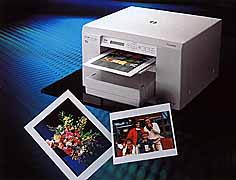
The Fujix NC-500 Thermo-Autochrome printer.

Production of photographic quality prints from digital image files has now been possible for some years. The Kodak XL7700 dye sublimation printer set the benchmark by which all other dye sub printers are judged
before it was replaced by the equally magnificent XLT7720. Intended for
military use, mounted in nineteen inch equipment racks, these printers are
built like battleships yet produce the most beautiful prints - up to
eleven inches square - on the highest quality media of any digital
printer. The paper is an elegant semi-matte, reminiscent of fine double-weight
photographic paper. Metameric properties - how the prints look in different
ambient illuminants, such as daylight, tungsten and fluorescent - beat
most later dye-sub printers.
After the £18,000 XLT7720 came the Kodak XLS8300, followed by the XLS8600.
The media is thinner, high gloss and has a not so attractive metallic look,
but these reliable, high quality machines are very fast, one third the price
and have become the standard.
The main problem is that dye sublimation printers generally only go up to
A4, occasionally A3. No good for large prints.
Up to A0 - 841x1188mm (33x46.75 inches) - the high quality field
has been left almost entirely to the Iris ink-jet printers, distributed
in the UK by Ilford. Capable of printing on a variety of media, including
hand-made watercolour paper, these printers are in a class of their own.
With new dyes, resistant to water and fading, they become archival quality.
But even the newer higher speed machines are not capable of volume throughput.
We are undoubtedly moving towards plain paper printers, though this is not
going to be popular with the suppliers of consumables, other than paper.
Before too long we will have multi-function A3 or larger machines which
will be flatbed scanner, colour photocopier, colour fax and photographic
quality colour laser printer all rolled into one. The indications are with
us already. A4 bubble jet colour printers of surprisingly good quality now
cost under £300. That same sum would buy a good dye-sub printer, the
Fargo FotoFUN - though it is restricted to a maximum print size of
6x4 inches. Colour laser printers such as the £4,500 A4 Apple Colour
LaserWriter 12/600PS with Colour Photograde are dramatically narrowing the
gap between photographic quality and simply being 'coloured'.
Other printers abound. Huge poster-sized machines can make giant 'joiners'
with much greater precision than photographic enlargements and chemical
processing. Hybrid systems such as the Metrum FotoPrint and Ilford Ilfochrome
Digital Imager (IDI) combine digital exposure with conventional chemical
processing to produce richly toned photographic prints without negative
or transparency. Fuji prefer to innovate, rather than take on the competition
with alternative versions of the same technology. Still something of an
unintentional Fuji 'secret', the Pictrography 3000 is probably the best
A4 digital printer made to date. Its prints have the most wonderful tonal
gradation with 400dpi sharpness. The price has recently been reduced from
£18,000 to around £12,000, which should help the Pictrography
build the larger user base it deserves.
Dye-sublimation printers have a donor ribbon which has to be thrown away
after use, along with its plastic carrier. The ribbon holds sufficient dye
to print the densest of images, so it is only partly exhausted when discarded.
Although less harmful to the environment than processing chemicals, this
is expensive and wasteful. Ink jet and laser printers also need consumables
and disposable carriers in addition to paper.
A printer which does not use any ribbon, ink, dye, toner, or chemicals,
does not produce any waste and only uses paper and a little electricity
seems an impossibility. But no, it's already a reality: Fuji's Thermo-Autochrome
system.
The first printer to use this new technology is the Fujix Fotojoy NC-1,
seen at Photokina in September 1994.
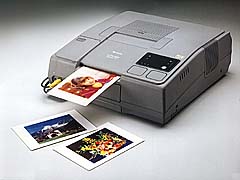
This small printer, 300mm wide x 110mm high x 310mm deep (12x4.25x12.25
inches), produces 78x100mm (3x4 inches) images on 100x140mm (4x5.5 inches)
paper at a resolution of about 150dpi from video (analogue) input, composite
or S-video, and will reproduce 128 levels of each of red, green and blue.
By the PMA show in London, late in 1995, there was a second generation printer:
the Fujix NC-500. This is a 300dpi device with SCSI digital input which
produces 24 bit images (256 levels of each of R, G and B) up to 200x277mm
(8x11 inches) on paper up to long A4, 210x325mm (8.3x12.8 inches). The printer
also produces images 200x249mm (8x10 inches) on true A4 size paper, and
'half size' images 200x132mm (8x5 inches) on 210x180mm (8.25x7.1 inches)
paper. Print time is just over two minutes.
At Photokina 1994, Fuji stated that 150 patents had been filed during the
development of their Thermo-Autochrome system. By PMA London, that number
had grown to 400. The quality of prints from the NC-500 was noticeably better
than from the NC-1 a year earlier, reflecting the additional work and patent
applications which had been necessary to refine the system.
The major advances are in the special paper, which uses an exclusive heat-sensitive
microcapsule system with a new diazo compound and coupler technology, held
in the three colour layers.
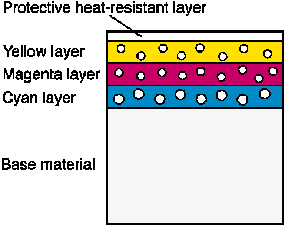
The image is formed by heating a thermal head - the 'Thermo' part
- in proportion to the amount of colour required to be synthesised
by the thermo-sensitive paper - the 'Autochrome' part. Prints have
a rich tonal range, said to be close to silver halide in quality. They are
crisp and vivid.
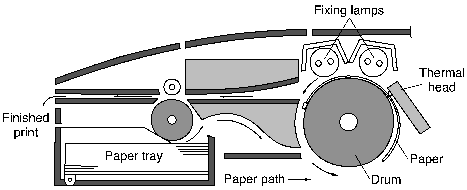
Because the printer mechanism is more simple than that in a dye sublimation
printer, Thermo-Autochrome printers should be very reliable, consistent,
maintenance free - and hopefully cheaper too. The absence of disposable
ribbons, inks, dyes, toners and chemicals should also keep the cost of consumables
down. Printers up to A0 and roll prints are said to be feasible and Fuji
are actively seeking new commercial alliances for their TA technology.
The print goes through three cycles as it is created. The paper is firmly
clamped to a drum which holds it in precise register for all three cycles.
The first cycle develops the yellow layer, using low thermal energy in the
thermal head. Heat is applied locally and precisely, every three hundredth
of an inch, in the correct proportion for the amount of colour required
in each specific point on the print. The yellow image is then 'fixed' by
exposing the entire print to a 420nm ultra-violet lamp, which decomposes
the undeveloped yellow colour elements, destroying their colour-synthesising
properties. The second cycle is the development of the magenta layer. This
uses mid-range thermal energy, which penetrates into the middle colour synthesising
layer of the paper. The magenta image is then 'fixed' by exposure to a 365nm
UV lamp. The third and final cycle is the development of the cyan image,
using high-range thermal energy to penetrate down to the lowest colour synthesising
layer.
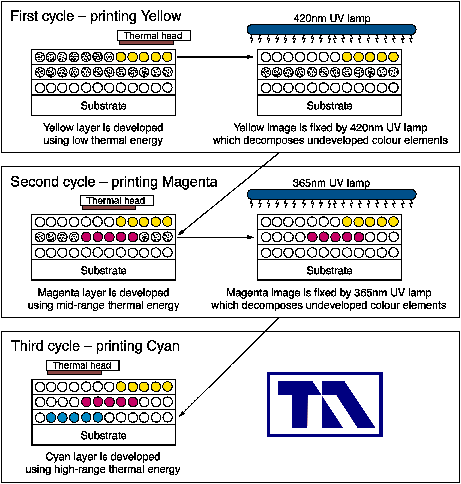
Thermo-Autochrome does not use any ribbon, ink, dye, toner, or chemicals.
Nor does it produce any waste. It only uses paper - and a little electricity.
Thermo-Autochrome is my tip as a major innovation to watch out for in 1996
and beyond. It has the potential to make a revolutionary impact on low-cost,
photographic quality digital colour printing.
Be sure to keep the price low, Fuji - and don't forget to shout it
from the rooftops.